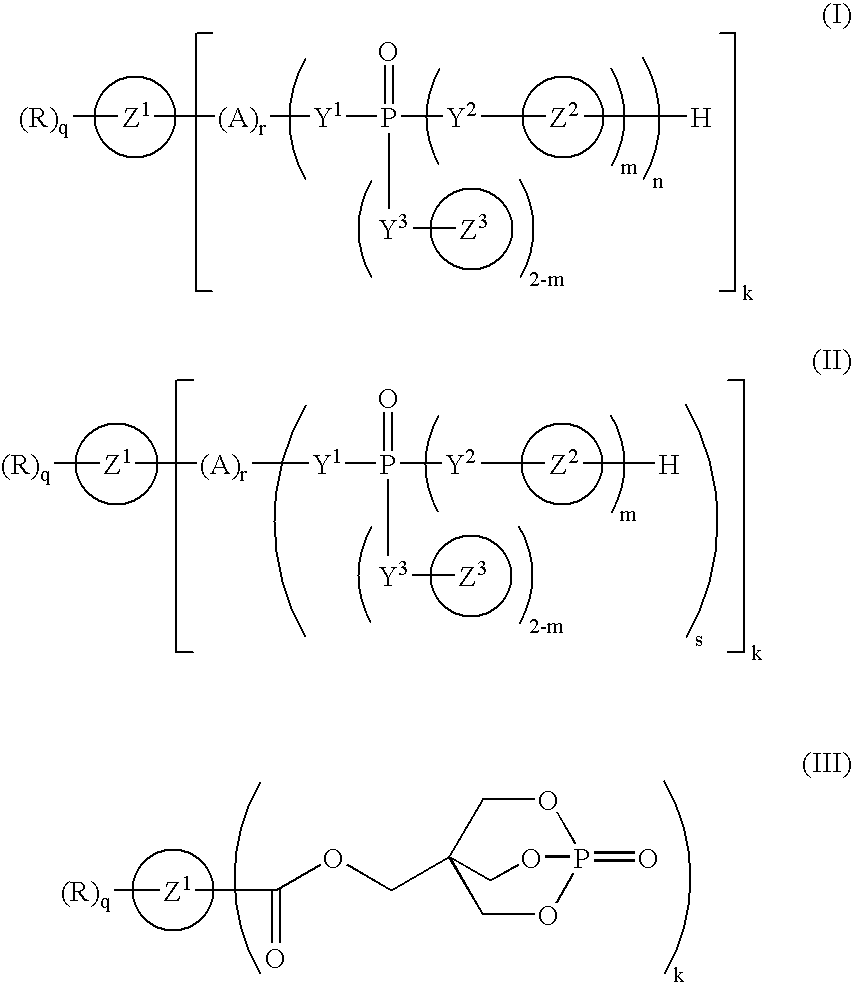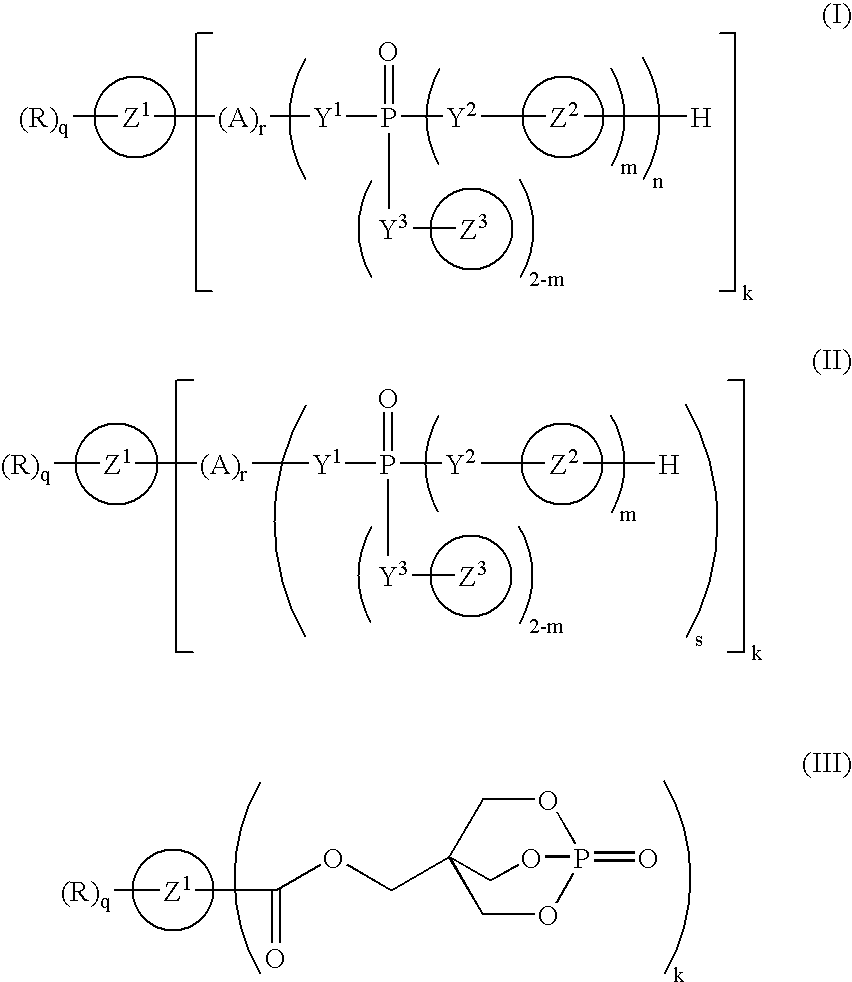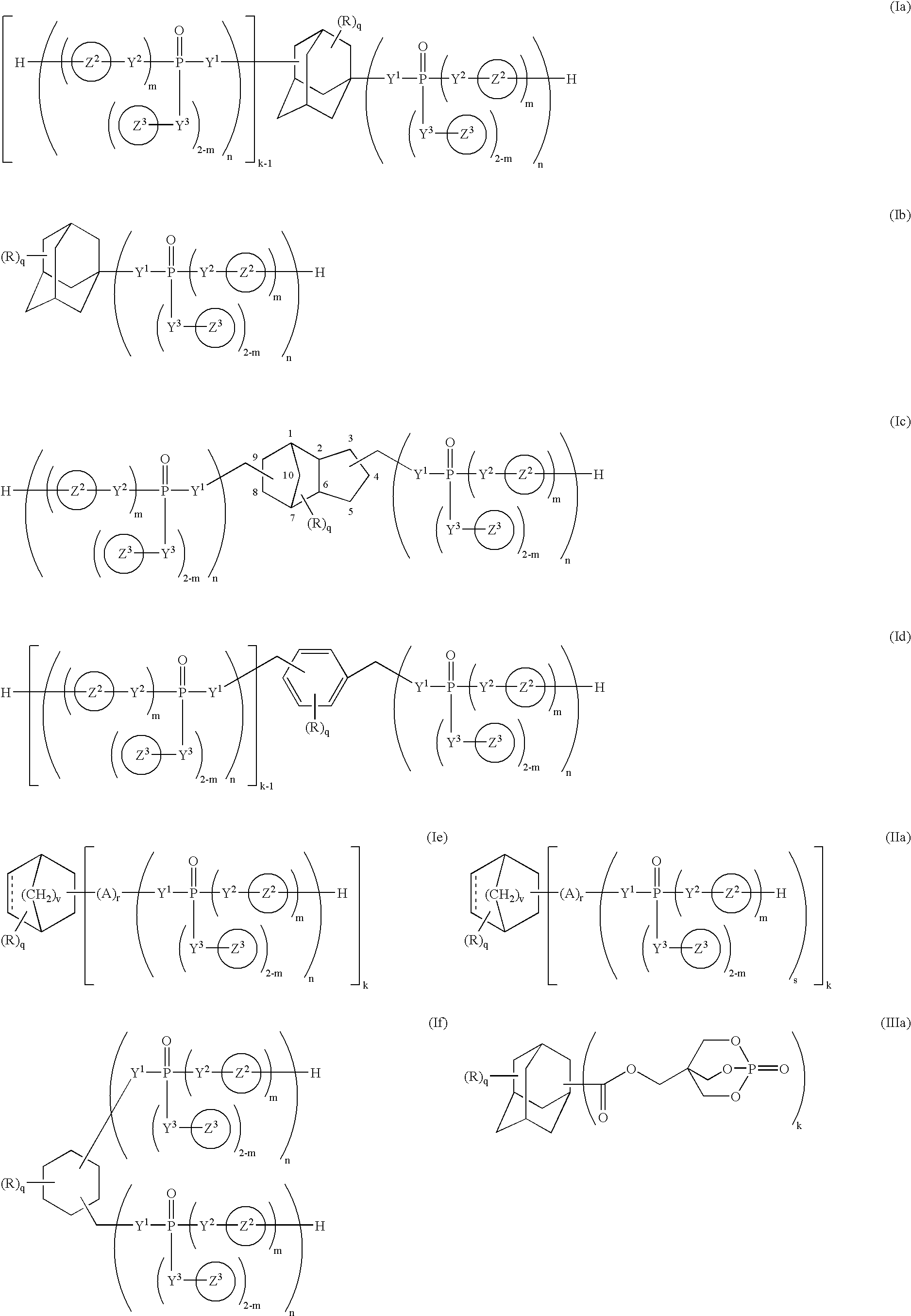Phosphorus compound
a technology of phosphorus and compound, applied in the field of phosphorus compound, can solve the problems of corroding metal molds, worse working environment, and deteriorating resin characteristics, and achieve the effect of improving the flame retardancy of resins
- Summary
- Abstract
- Description
- Claims
- Application Information
AI Technical Summary
Benefits of technology
Problems solved by technology
Method used
Image
Examples
example a1
##STR14##
Adamantylbis(diphenylphosphate) was prepared according to the reaction scheme.
Into a three-neck flask (500 ml) equipped with a dropping funnel, a Dimroth condenser and a calcium chroride (CaCl.sub.2) tube, were fed 40.1 g (238 mmol) of adamantanediol and 235.1 g (2.97 mol) of pyridine, and 159.7 g (595 mmol) of diphenylphosphorochloridate was added dropwise to the mixture for 30 minutes at 60.degree. C. with stirring. After dropping was completed, the reaction was effected at 90.degree. C. for 2.5 hours.
The reaction mixture was cooled to room temperature, and 400 ml of ethyl acetate and 400 ml of water were added to the reaction mixture for extraction of an object compound. Further, an organic layer was washed with 400 ml of 2N (2 mol / L) hydrochloric acid three times, 400 ml of saturated sodium carbonate aqueous solution three times, and 400 ml of water one time in this order. The organic layer was dried with sodium sulfate and evaporated.
The obtained oil was recrystallized...
example a2
##STR15##
Dimethyladamantylbis(diphenylphosphate) was prepared according to the reaction scheme.
Into a three-neck flask (500 ml) equipped with a dropping funnel, a Dimroth condenser and a calcium chroride (CaCl.sub.2) tube, were fed 42.2 g (215 mmol) of dimethyl adamantanediol and 213 g (2.69 mol) of pyridine, and 148 g (55.1 mmol) of diphenylphosphorochloridate was added dropwise to the mixture for 30 minutes at 60.degree. C. with stirring. After dropping was completed, the reaction was effected at 90.degree. C. for 7 hours.
The reaction mixture was cooled to room temperature, and 400 ml of ethyl acetate and 400 ml of water were added to the reaction mixture for extraction of an object compound. Further, an organic layer was washed with 400 ml of 2N (2 mol / L) hydrochloric acid three times, 400 ml of saturated sodium carbonate aqueous solution three times, and 400 ml of water one time in this order. The organic layer was dried with sodium sulfate and evaporated.
The resultant residue w...
example a3
##STR16##
Adamantyltris(diphenylphosphate) was prepared according to the reaction scheme.
Into a three-neck flask (500 ml) equipped with a dropping funnel, a Dimroth condenser and a CaCl.sub.2 tube were fed 20 g (109 mmol) of adamantanetriol and 150 g (1.9 mol) of pyridine, and 103 g (382 mmol) of diphenylphosphoric chloride was added dropwise to the mixture for 25 minutes at 70.degree. C. under stirring. After dropping was completed, the reaction was effected under 90.degree. C. for 7 hours.
The reaction mixture was cooled to room temperature, and 300 ml of dichloromethane was added to the reaction mixture for extracting an object compound. Further, the extract was washed with 170 ml of 2N (2 mol / L) hydrochloric acid three times, 300 ml of water one time, 300 ml of 15% by weight Na.sub.2 CO.sub.3 aqueous solution two times, and 300 ml of water one time in this order. The organic layer was dried with sodium sulfate, and then solvents were evaporated to obtain the objective adamantyltri...
PUM
| Property | Measurement | Unit |
|---|---|---|
| temperature | aaaaa | aaaaa |
| temperature | aaaaa | aaaaa |
| temperature | aaaaa | aaaaa |
Abstract
Description
Claims
Application Information
 Login to View More
Login to View More - R&D
- Intellectual Property
- Life Sciences
- Materials
- Tech Scout
- Unparalleled Data Quality
- Higher Quality Content
- 60% Fewer Hallucinations
Browse by: Latest US Patents, China's latest patents, Technical Efficacy Thesaurus, Application Domain, Technology Topic, Popular Technical Reports.
© 2025 PatSnap. All rights reserved.Legal|Privacy policy|Modern Slavery Act Transparency Statement|Sitemap|About US| Contact US: help@patsnap.com



